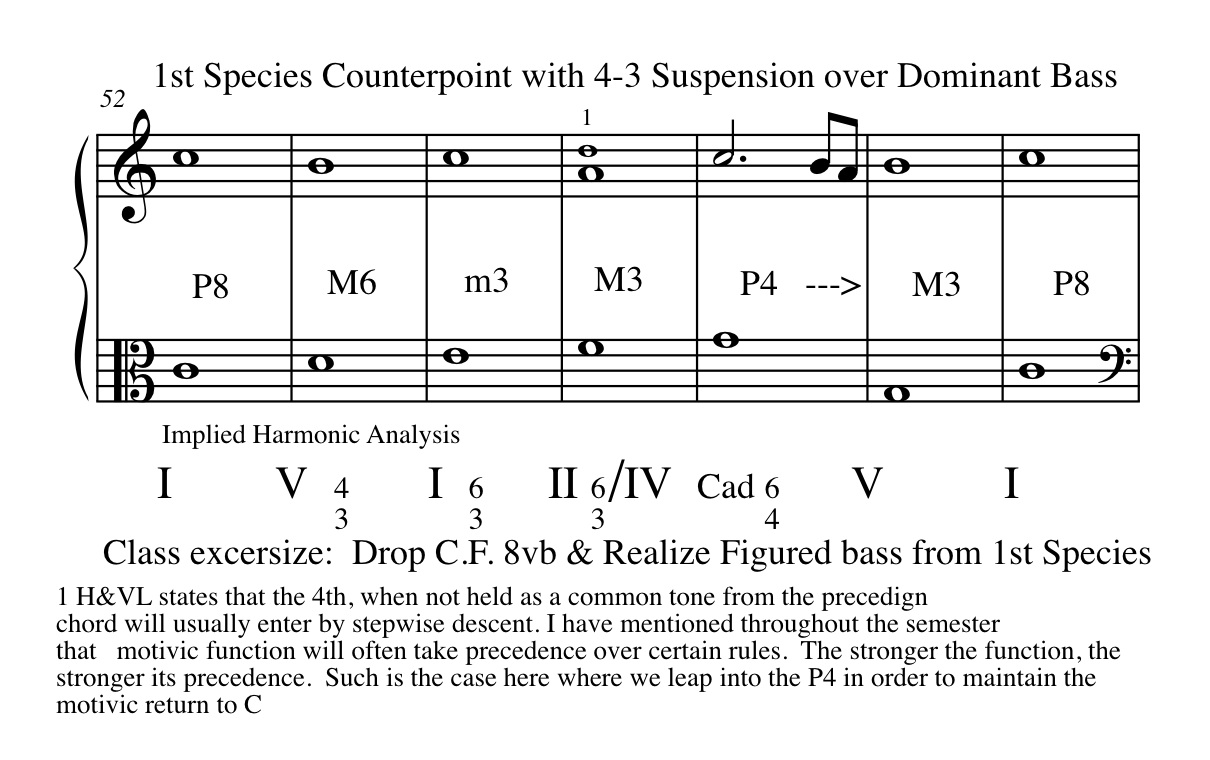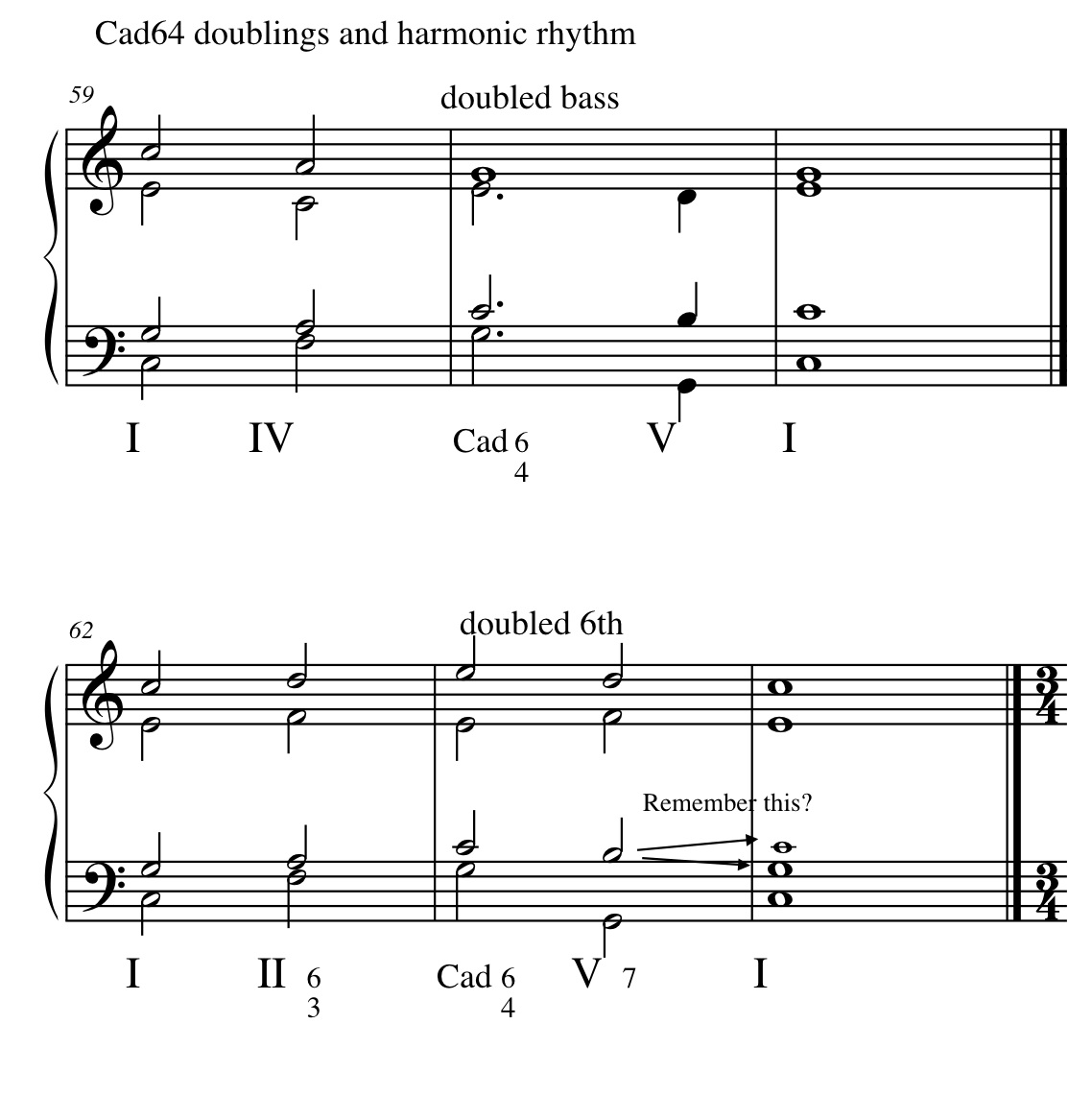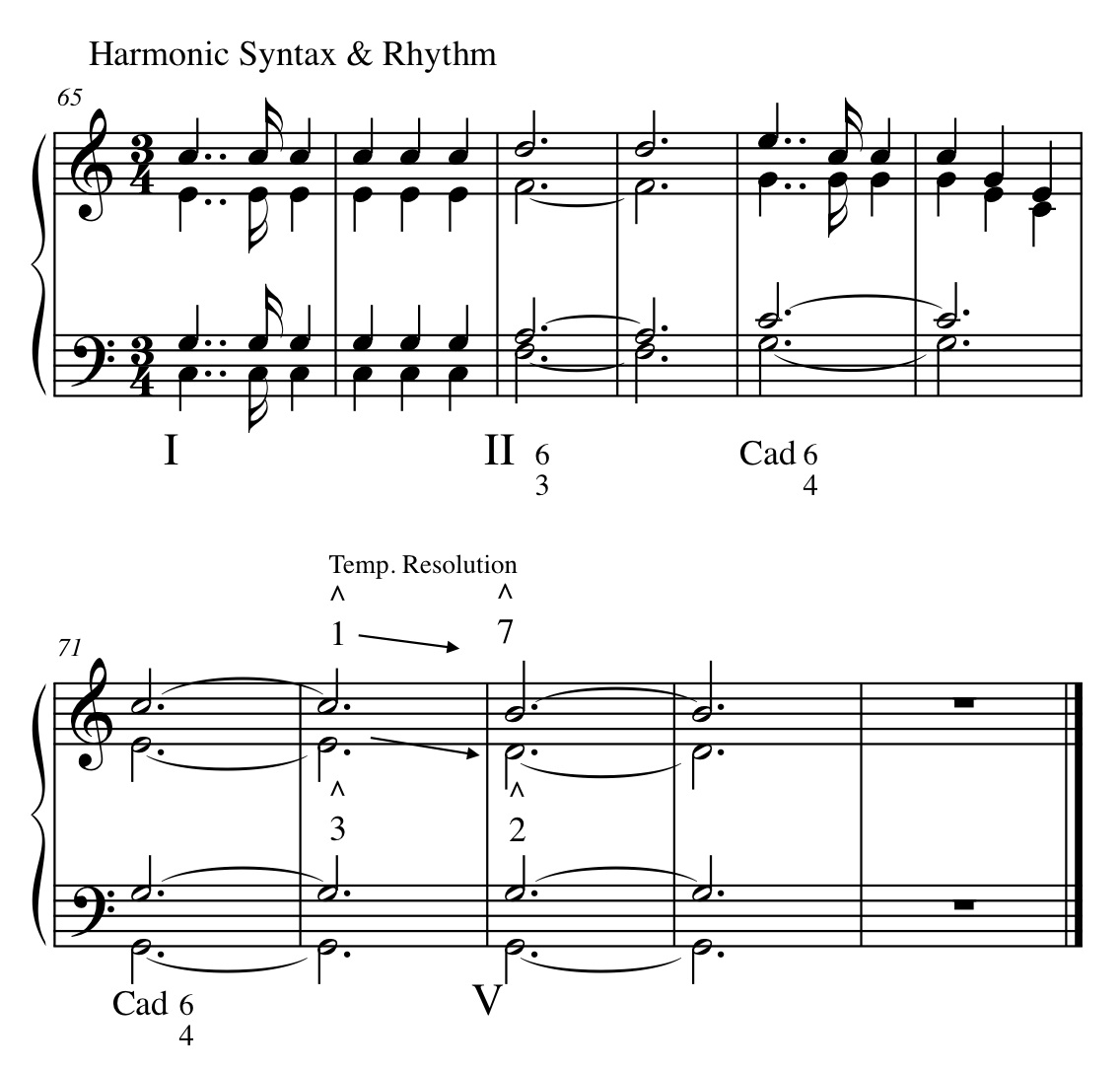From the beginning, we have discussed the dualality of the P4th interval. At times, the interval appears as a connsonance and at other times it acts clearly as a dissonance. In the last chapter we saw the significance of the ^4 scale degree (the diatonic P4) and how, as part of an intermediary harmony it becomes a prepared deissonance or suspension when leading to V7 or inversions. Just as that dissonance had to resolve, so to will the dissonant P4 in the I64 need to resolve.
Homework: Workbook Chapter 8 Pg 61 all, pg 62#1, pg 65#4 (give complete Roman and arabic numeral analysis)
An intensification of V

1. Non-tonic Function
a. If we analyze the above reduction, we see that we have a simple but lovely I-V43-I6 opening harmony followed by an intermediary IV5. What happens next is quite new to us. If we litterally spell the chord in the 5th measure of this reduction (7th measure in actual piece) we see a "I64" chord. This chord follows an intermediary harmony and as we learned in the last chapter, with the exception of the "PI6" a I chord does not follow an intermediary harmony but rather leads to it. As well, we have seen and heard the I chord as a very stable harmonic unit and this chord is anything but stable. In fact, it leads so strongly to the following V6 that we can think of it as an integral part of the V chord. The presence of the P4 in the chord creates such a strong active dissonance that, just as we saw the preparation of the V7 dissonance by the intermediary harmonies II, II6 and IV, we can think of this P4 and 6th as an anticipatory embellishment of the subsequent V chord. As such, H&VL states that labeling this chord a I chord would be unwise. As such they call it a V64. In my opinion this definiton over-states the relationship of this chord to the dominant and I prefer to simply call it a "Cad64" You may call it either.
2. Origin of the Cad64
a. Before the days of the systematic harmonic analysis we are heretofore undertaking, composers wrote harmonies based strictly on intervalic relationships. Much of their impressions of connsonance and dissonance carried over to later generations. In particular, the suspension of a 4th above a dominant cantus firmus (think 1st species counterpoint) was a fairly standard part of the harmonic syntax. As chordal harmony evolved, the suggestion of a suspension over a complete dominant harmony was further elaborated by suspending the 6th above the bass as well.

3. Voice Leading
a. As with all other "normal" resolutions of dissonances, the 4th in the Cad64 will resolved down. When it is not held over from the previous harmony, it often enters by stepwise decent as an accented passing or neighbor tone.
4-5. Moving to V7 & Doubling.
a. Since the Cad64 is an integral part of the dominant harmony, it moves most naturally to V7 with the ^1 (4th above the bass) resolving down to the leading tone and the ^3 (6th above the bass) resolving down to the ^2 (5th above bass of V7) Sometimes, we will see the ^3 resolve up to the ^4 to create the 7th of the V7. When the ^3 is doubled it is obviously best to have one lead to the ^2 and the other lead to the ^4 to avoid parallelisms. In four part writing, it is best to double the bass (most stable) then the 6th above (consonant). Try to avoid the 4th (dissonant) unless it appears in free or complex textures.

5. Rhythm
a. Like the suspension of the ^4 in a II/II6/IV - V7 (inv) progression, the suspensions in the Cad64 should occur on a metrically relatively strong beat and resolve on the following weak beat. (or in the case of slow progressions the resolution may occur on the next strong beat)
6. Moving to V7
a. IV II and II6 all move well to V7. In fact they all share the 4th scale degree. When this 4th scale degree is present in the same voice in the IV, or II or II6 chord AND in the V7, the dissonance in the V7 is said to be "prepared", Throughout our study of harmony, we will see many benefits to preparing dissonances. When the preparation of the dissonance occurs on a strong beat the preparation is called a "suspension". The strength of the prepared 7th is significant and, at times can warrant its doubling.

7. Cadences
a. The Cad64 as part of dominant harmony can therefore also be part of an authentic or semicadence.
b. Sometimes, the Cad64 can be prolonged to heighted the sense of tension created by the dissonance (play ex 10-8)
8-9. Melodic lines and functions of ^1, ^7, ^3, ^2
a. Since the Cad64 appears as a dissonance whose 4th above the bass (^1) must resolve (to ^7) the normal role of the Leading Tone (^7) as highly active and unstable gets reversed and temporarily becomes a point of resolution. Similarly the 6th above the bass (^3) also must resolve, (usually to ^2) and the otherwise stable ^3 now becomes less stable and moves to the otherwise active ^2 as a point of temporary repose.
10. Harmonic Syntax
a. If the Cad64 were to be preceded by a chord containing the leading tone (variations of V or Vii6) we would spoil the harmonic party created by the delayed resolution to ^7 of the Cad64. Therefore, we will say that the Cad64 is approached only from intermediate harmonies or a tonic chord
Insert Hamonic Syntax and Rhythm
11-12. Non-cadential uses of Cad64 and phrase rhythm
a. Although the Cad64 is followed by a V variant, it need not embellish a cadential V. One good way to avoid a stong cadential effect is to resolve the Cad64 to a V42. The active dissonance in the bass of the V42 and subsequent I6 will avoid an unwanted stong cadence. (see example 10-11) This can also be used to prolong or extend a phrase (see ex 10-13 a+b)
13. Back Relating Dominants
a. On occassion we may see a dominant function as a larger part of a tonic unit. as is the case with "subordinate progressions" (chapter 9-16) Sometimes, these subordinate progressions will end on a V chord in a semi-cadence manner but be immediately followed by something other than a I chord. In such cases we must consider the harmonic implications of the enitre subordinate phrase. (See example 10-10)
14. Antecedent-Consequent construction
a. A more formal study of composition and form presents this most important relationship. In a nutshell, one of the smallest elements of a coherent musical idea is called a phrase. Typically this element is 4 bars long and ends in either a full or semi-cadence. Two phrases that are in someway connected to each other form a larger unit called a period. In a period the first phrase is called the Antecedent and the second is called a Consequent.
|

